Translate this page into:
On the thermal analysis of magnetohydrodynamic Jeffery fluid via modern non integer order derivative
⁎Corresponding author. kashif.abro@faculty.muet.edu.pk (Kashif Ali Abro)
-
Received: ,
Accepted: ,
This article was originally published by Elsevier and was migrated to Scientific Scholar after the change of Publisher.
Peer review under responsibility of King Saud University.
Abstract
The uniqueness of thermal radiation effects on materials has an adhesive role in engineering. This article emphasizes the effects of thermal radiation of Jeffery fluid with magnetic field by employing Caputo-Fabrizio fractional derivative. Analytical solutions for the velocity field and temperature distribution are based on integral transforms (Fourier Sine and Laplace transform) with their inversion. The general solutions have been established in terms of elementary functions and product of convolution theorem satisfying initial and boundary conditions. This analysis is one of the infrequent contributions to elucidate the rheology of Jeffery fluid for free convective problem on oscillating plate. In order to bring physical insights, four models have been prepared for comparison i-e (i) Jeffery fluid with magnetic field (ii) Jeffery fluid without magnetic field (iii) Second grade fluid with magnetic field and (iv) Second grade fluid without magnetic field for several rheological parameters for instance, viscosity , thermal radiation , thermal conductivity , Jeffrey fluid parameter , Hartmann number , magnetic field , Prandtl number , Grashof number on fluid flow. At the end, our results suggested that Ordinary Jeffery fluid with magnetic field oscillates more rapidly to remaining models of fluid but fractionalized Jeffery fluid with magnetic field has reciprocal behavior of fluid flow.
Keywords
Thermal radiation
Jeffery fluid
Caputo-Fabrizio fractional derivative
Fourier Sine and Laplace transform
1 Introduction
The computational and physico-mathematical analysis in non-Newtonian fluid has diverted the attention of various researchers; this is due to broad applications of certain fluids in engineering such as industrial adhesives and lubricants (Ver Strate and Struglinski, 1991), gels, drugs and creams (Suryawanshi et al., 2012), plastics fabrication (Balmforth and Craster, 1999), and also ecological systems comprising hyper-concentrated sediments, mud flows, contaminant release and oil spills (Jokuty et al., 1995). The conventional Navier-Stokes viscous model (Newtonian) invalidates non-Newtonian fluids due to intrinsic properties. Newtonian fluid is insufficient to describe the dynamics and rheological phenomenon of many fluids for instance, Weissenberg effects, shear-thinning/thickening, stress differences, fading memory, spurt, yield stress, elongation, retardation, relaxation, re-coil, micro-structure and several others. Different models have been proposed to characterize the rheology of non-Newtonian fluid few of them are; Burgers elasto-viscous fluid model (Tripathi and Anwar Bég, 2014), Sisko’s model (Sisko, 1958), differential third and second grade fluid models (Reiner-Rivlin) (Sahoo and Poncet, 2011; Sarpkaya and Rainey, 1971), Oldroyd-B fluid model (Khan et al., 2012), Maxwell fluid model (Abro et al., 2015; Abro and Shaikh, 2015), Jeffery’s model (Qasim, 2013). The Jeffery fluid model is viscoelastic non-Newtonian fluid that exhibits retardation and relaxation phenomenon. The Jeffery fluid model is simpler linear model in which convective derivative is omitted for time derivative. For this cause, several investigations have been carried on Jeffery fluid few of them are hereby cited. Hayat and et al. have traced out Jeffrey fluid for unsteady mixed convection flow under the existence of thermal radiation over a stretching sheet (Hayat and Mustafa, 2010). The Jeffrey fluid for stagnation point flow on unsteady oscillations has been analyzed by Nadeem et al. (2014). Hayat et al. (2012) have investigated the flow of Jeffery fluid in the presence and absence of radiation under the influences of heat source and power law heat flux. Shehzad et al. (2013) worked out on the radiative flow of Jeffrey fluid under impacts of joule heating and thermophoresis with mixed convection. Khan (2015) examined effects the unsteady free convection flow of a Jeffrey fluid and traced out an exact solution. Dalir (2014) investigated heat transfer and convection flow of a Jeffrey fluid with entropy generation over a stretching sheet using Numerical study. Hayat et al. (2010) worked on fractionalized Oscillatory and rotational flows of Jeffrey fluid in porous medium. Idowu et al. (2013) emphasized the impacts of unsteady magnetohydrodynamic flow of Jeffrey fluid with chemical reaction, mass and heat transfer in a horizontal channel. Off course, the study can be continued but we end here by citing few recent studies on magnetic field (Abro and Solangi, 2017; Sheikholeslami and Rokni, 2018; Abro et al., 2018; Atangana and Koca, 2016; Abro et al., 2017), thermal radiation (Abro et al., 2018; Khan and Abro, 2018), Porous medium (Abro et al., 2017; Abro et al., 2017), heat and mass transfer (Atangana, 2016; Sheikholeslami et al., 2018; Abro and Khan, 2017; Sheikholeslami et al., 2018; Abro et al., 2018; Mohyud-Din et al., 2015; Khan et al., 2017), nanofluids (Sheikholeslami et al., 2018; Sheikholeslami et al., 2018; Khan et al., 2017) and modern fractional derivatives (Al-Mdallal et al., 2018; Saad et al., 2017; Abro et al., 2018; Atangana and Baleanu, 2017; Laghari et al., 2017). Motivating by all mentioned models, our aim is to emphasize the effects of oscillating flow of Jeffery fluid for magnetic field and thermal radiation by employing Caputo-Fabrizio fractional derivative. Analytical solutions for the velocity field and temperature distribution are based on integral transforms (Fourier Sine and Laplace transform). The general solutions have been established in terms of elementary functions and product of convolution theorem satisfying initial and boundary conditions. This analysis is one of the infrequent contributions to elucidate the rheology of Jeffery fluid for free convective problem on oscillating plate. In order to bring physical insights, four models have been prepared for comparison i-e (i) Jeffery fluid with magnetic field (ii) Jeffery fluid without magnetic field (iii) Second grade fluid with magnetic field and (iv) Second grade fluid without magnetic field for several rheological parameters for instance, viscosity
, thermal radiation
, thermal conductivity
, Jeffrey fluid parameter
, Hartmann number
, magnetic field
, Prandtl number,
, Grashof number on fluid flow (see Fig. 1).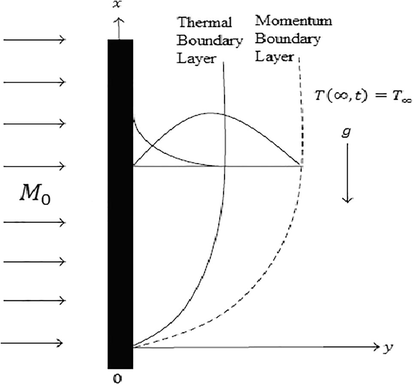
Geometry of Jeffery Fluid for Vertical Plate.
2 Governing equations
The governing equation which describes unsteady incompressible flow
Implementing dimensionless numbers and variables,
where,
,
,
,
,
,
,
,
,
,
,
,
,
,
,
are the time, velocity distribution, Non-zero parameter, viscosity, spatial variable, thermal radiation, temperature, Stefan-Boltzmann, absorption coefficient, thermal conductivity, Jeffrey fluid parameter, Hartmann number, magnetic field, Prandtl number, Grashof number respectively. The corresponding governing differential equations and initial and boundary conditions from Eqs. (6)-(10) are termed as
3 Profile of temperature distribution via Fourier Sine transform
Employing Fourier Sine Transform on fractionalized differential equation, Multiplying both sides of (15)
, integrating the result with respect to y from 0 to infinity (Abro et al., 2016), and considering Eq. (16)1 in mind the initial and boundary condition, we obtain
Implementing Laplace transform on Eq. (20) and (1618)1, we get
Inverting Eq. (23) by Fourier Sine transform, we obtain
4 Profile of velocity field via Fourier Sine transform
The case of cosine oscillation
Employing Fourier Sine Transform on fractionalized differential equation, Multiplying both sides of (14)
, integrating the result with respect to y from 0 to infinity, and considering equation (16)2 in mind the initial and boundary condition, we obtain
Implementing Laplace transform on equations (26) and (1618)2, we get
Applying inverse Laplace transform on Eq. (30), we have final form of velocity field in term of integral form as
5 Limiting cases
5.1 Temperature distribution and velocity field without the effects of radiation when
The solutions of temperature distribution and velocity field without the effects of radiation cab be recovered by letting
in equations (25) and (30), (31) obtained by (Khan, 2015)
5.2 Velocity field without the effects of magnetic field when
The solutions of velocity field without the effects of transverse magnetic field cab be investigated by employing
in Eqs. (30) and (31)
5.3 Velocity field for Second grade fluid with magnetic field when and
The solutions of velocity field with the effects of transverse magnetic field for second grade fluid can be traced out by employing
and
in Eqs. (30) and (31) obtained by (Samiulhaq et al., 2014)
6 Discussions and concluding remarks
In this portion, influences of thermal radiation, magnetic field, Caputo–Fabrizio fractional parameter and various physical parameters elucidate the distinct properties of fluid flow on the oscillations on Jeffery fluid. The Caputo–Fabrizio fractionalized partial differential equations are solved by utilizing discrete Laplace and Fourier Sine transforms with their inverses. The general and particularized solutions satisfy initial and boundary conditions as expected. However, the summary of this problem is emphasized with focal points listed below:
-
Fig. 2 is depicted to emphasize the effects of thermal radiation on temperature and velocity profiles. It is observed that profile of temperature is sequestrating while velocity field has scattering behavior of fluid flow over the boundary of plate. This is due to increase in thermal radiation which produces sequestrating and scattering behavior of fluid flow.
-
Fig. 3 is prepared to illustrate the influence on temperature field for viscous and thermal forces and velocity profile for buoyancy forces. It is noted that profiles of temperature and velocity field have quit identical behavior to each other while increase in Prandtl number and Grashof number respectively.
-
The effect of transverse magnetic field is highlighted in Fig. 4, in which pattern of oscillating is dominant in velocity distribution. Due to applied magnetic field, flow of velocity field is smattering and scattering with monotonic effect.
-
The Caputo–Fabrizio fractional parameter is emphasized in Fig. 5 to characterize memory properties on temperature distribution and velocity field. The effect of Caputo–Fabrizio fractional parameter seems to be identical qualitatively as expected for both temperature and velocity.
-
Fig. 6 is prepared for comparison of ordinary velocity field and fractionalized velocity field with four models i-e (i) Jeffery fluid with magnetic field (ii) Jeffery fluid without magnetic field (iii) Second grade fluid with magnetic field and (iv) Second grade fluid without magnetic field. It is worth pointing out that ordinary fluid is extremely sequestrating in contrast with fractionalized fluid. Ordinary Jeffery fluid with magnetic field oscillates more rapidly to remaining models of fluid but fractionalized Jeffery fluid with magnetic field has reciprocal behavior of fluid flow. The similar phenomenon can also be assessed for temperature distribution via graphical illustrations as well.

- Effects of thermal radiation on temperature distribution and velocity field.
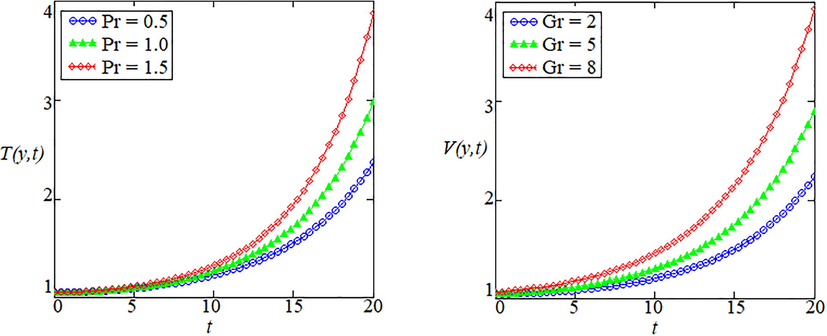
- Effects of Prandtl and Grashof number on temperature distribution and velocity field.
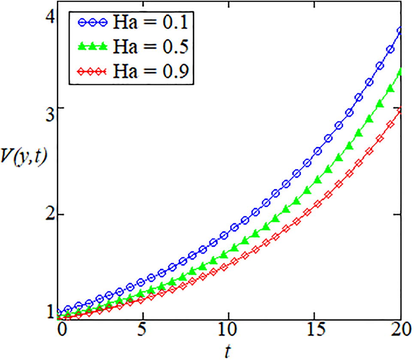
- Effects of Hartman number on the velocity field.
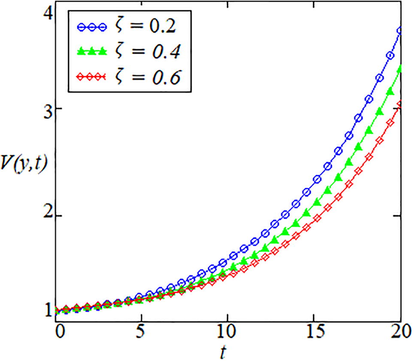
- Effects of Caputo-Fabrizio fractional parameter on the velocity field.
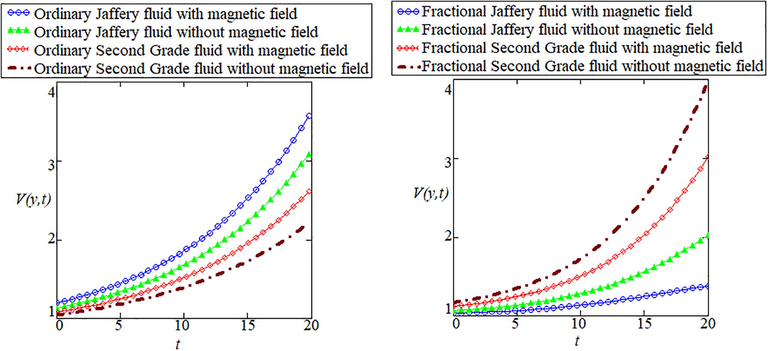
- Comparison of Ordinary Jaffery and Second grade fluid with and without magnetic field on the velocity field.
References
- Polymers as lubricating-oil viscosity modifiers. In: Polymers as Rheology Modifiers, Proceedings of the ACS Symposium Series. American Chemical Society; 1991. p. :256-272.
- [Google Scholar]
- J. Adv. Pharmaceut. Technol. Res.. 2012;2:67.
- J. Non-Newtonian Fluid Mech.. 1999;84:65.
- A Study of Viscosity and Interfacial Tension of Oils and Emulsions. Ottawa, Ontario: Environment Canada Manuscript Report Number EE-153; 1995.
- Peristaltic propulsion of generalized Burgers’ fluids through a non-uniform porous medium: A study of chyme dynamics through the diseased intestine. Math. Biosci.. 2014;248:67-77.
- [Google Scholar]
- Flow and heat transfer of a third grade fluid past an exponentially stretching sheet with partial slip boundary condition. Int. J. Heat and Mass Trans., Elsevier. 2011;54:5010-5019.
- [Google Scholar]
- Stagnation point flow of a second-order viscoelastic fluid. Acta Mech.. 1971;11:237.
- [Google Scholar]
- Hydromagnetic rotating flows of an Oldroyd-B fluid in a porous medium. Spec. Top. Rev. Porous Media. 2012;3:89-95.
- [Google Scholar]
- Analytical Solutions Under No Slip Effects for Accelerated Flows of Maxwell Fluids, Sindh Univ. Res. Jour. (Sci. Ser.). 2015;47:613-618.
- [Google Scholar]
- Exact analytical solutions for Maxwell fluid over an oscillating plane. Sci. Int. (Lahore) ISSN.. 2015;27:923-929.
- [Google Scholar]
- Heat and mass transfer in a Jeffrey fluid over a stretching sheet with heat source/sink. Alexandria Eng. J.. 2013;52:571-575.
- [Google Scholar]
- Influence of thermal radiation on the unsteady mixed convection flow of a Jeffrey fluid over a stretching sheet. Z. Naturforsch.. 2010;65:711-719.
- [Google Scholar]
- Unsteady oscillatory stagnation point flow of a Jeffrey fluid. J. Aerosp. Eng.. 2014;27(3):636-643.
- [Google Scholar]
- Radiative flow of Jeffery fluid in a porous medium with power law heat flux and heat source. Nucl. Eng. Des.. 2012;243:15-19.
- [Google Scholar]
- Influence of thermophoresis and joule heating on the radiative flow of Jeffrey fluid with mixed convection. Braz. J. Chem. Eng.. 2013;30(4):897-908.
- [Google Scholar]
- A note on exact solutions for the unsteady free convection flow of a jeffrey fluid. Z. Naturforschung A. 2015;70(6):272-284.
- [Google Scholar]
- Numerical study of entropy generation for forced convection flow and heat transfer of a Jeffrey fluid over a stretching sheet. Alexandria Eng. J.. 2014;53(4):769-778.
- [Google Scholar]
- Oscillatory rotating flows of a fractional Jeffrey fluid filling a porous space. J. Porous Media. 2010;13(1):29-38.
- [Google Scholar]
- Effect of heat and mass transfer on unsteady MHD oscillatory flow of Jeffrey fluid in a horizontal channel with chemical reaction. IOSR J. Math.. 2013;8(5):74-87.
- [Google Scholar]
- Heat transfer in magnetohydrodynamic second grade fluid with porous impacts using caputo-fabrizoi fractional derivatives. Punjab Univ. J. Math.. 2017;49(2):113-125.
- [Google Scholar]
- Magnetic nanofluid flow and convective heat transfer in a porous cavity considering Brownian motion effects. Phys. Fluids. 2018;30:012003
- [CrossRef] [Google Scholar]
- A mathematical analysis of magnetohydrodynamic generalized burger fluid for permeable oscillating plate. Punjab Univ. J. Mathematics. 2018;50(2):97-111.
- [Google Scholar]
- Chaos in a simple nonlinear system with Atangana-Baleanu derivatives with fractional order. Chaos, Solitons Fractals. 2016;89:447-454.
- [Google Scholar]
- An analytic study of molybdenum disulfide nanofluids using modern approach of atangana-baleanu fractional derivatives. Eur. Phys. J. Plus Eur. Phys. J. Plus. 2017;132:439.
- [CrossRef] [Google Scholar]
- Dual thermal analysis of magnetohydrodynamic flow of nanofluids via modern approaches of Caputo-Fabrizio and Atangana-Baleanu fractional derivatives embedded in porous medium. J. Therm. Anal. Calorim. 2018:1-11.
- [CrossRef] [Google Scholar]
- Thermal analysis in Stokes’ second problem of nanofluid: applications in thermal engineering. Case Stud. Thermal Eng.. 2018;10
- [CrossRef] [Google Scholar]
- Analytical solution of MHD generalized burger’s fluid embedded with porosity. Int. J. Adv. Appl. Sci.. 2017;4(7):80-89.
- [Google Scholar]
- Influence of slippage in heat and mass transfer for fractionalized MHD flows in porous medium. Int. J. Adv. Appl. Math. Mech.. 2017;4(4):5-14.
- [Google Scholar]
- On the new fractional derivative and application to nonlinear Fisher's reaction-diffusion equation. Appl. Math. Comput.. 2016;273:948-956.
- [Google Scholar]
- Experimental investigation for entropy generation and exergy loss of nano-refrigerant condensation process. Int. J. Heat Mass Transf.. 2018;125:1087-1095.
- [Google Scholar]
- Analysis of heat and mass transfer in MHD flow of generalized casson fluid in a porous space via non-integer order derivative without singular kernel. Chin. J. Phys.. 2017;55(4):1583-1595.
- [Google Scholar]
- Nanofluid flow and forced convection heat transfer due to Lorentz forces in a porous lid driven cubic enclosure with hot obstacle. Meth. Appl. Mech. Eng.. 2018;338:491-505.
- [Google Scholar]
- Analysis of stokes’ second problem for nanofluids using modern fractional derivatives. J. Nanofluids. 2018;7:738-747.
- [Google Scholar]
- On heat and mass transfer analysis for the flow of a nanofluid between rotating parallel plates. Aerosp. Sci. Technol.. 2015;46:514-522.
- [Google Scholar]
- Atangana-baleanu and caputo fabrizio analysis of fractional derivatives for heat and mass transfer of second grade fluids over a vertical plate: a comparative study. Entropy. 2017;19(8):1-12.
- [Google Scholar]
- Water based nanofluid free convection heat transfer in a three dimensional porous cavity with hot sphere obstacle in existence of Lorenz forces. Int. J. Heat Mass Transf.. 2018;125:375-386.
- [Google Scholar]
- Heat transfer improvement and pressure drop during condensation of refrigerant-based nanofluid; an experimental procedure. Int. J. Heat Mass Transf.. 2018;122:643-650.
- [Google Scholar]
- Heat transfer enhancement in hydromagnetic dissipative flow past a moving wedge suspended by H2O-aluminum alloy nanoparticles in the presence of thermal radiation. Int. J. Hydrogen Energy. 2017;42:24634-24644.
- [Google Scholar]
- Analytical solutions of fractional Walter’s-B fluid with applications. Complexity 2018 Article ID 8918541
- [Google Scholar]
- Generalized groundwater plume with degradation and rate-limited sorption model with Mittag-Leffler law. Res. Physics. 2017;7:4398-4404.
- [Google Scholar]
- A comparative mathematical analysis of RL and RC electrical circuits via Atangana-Baleanu and Caputo-Fabrizio fractional derivatives. Eur. Phys. J. Plus. 2018;133:113.
- [CrossRef] [Google Scholar]
- Caputo-Fabrizio derivative applied to groundwater flow within confined aquifer. J. Eng. Mech.. 2017;143(5):D4016005.
- [Google Scholar]
- Helical flows of fractional viscoelastic fluid in a circular pipe. Int. J. Adv. Appl. Sci.. 2017;4(10):97-105.
- [Google Scholar]
- A new definition of fractional derivative without singular kernel. Progr. Fract. Differ. Appl.. 2015;1(2):73-85.
- [Google Scholar]
- Heat transfer analysis in a second grade fluid over and oscillating vertical plate using fractional Caputo–Fabrizio derivatives. Eur. Phys. J. C 2016:362-376.
- [Google Scholar]
- Flow over an infinite plate of a viscous fluid with non-integer order derivative without singular kernel. Alexandria Eng. J.. 2016;55(3):2789-2796.
- [Google Scholar]
- Exact solutions on the oscillating plate of maxwell fluids. Mehran Univ. Res. J. Eng. Technol.. 2016;35(1):157-162.
- [Google Scholar]
- Porous effects on second grade fluid in oscillating plate. J. Appl. Environ. Biol. Sci.. 2016;6:71-82.
- [Google Scholar]
- Free, convection flow of a second-grade fluid with ramped wall temperature. Heat Trans. Res.. 2014;45(7):579-588.
- [Google Scholar]
- Influence of thermal radiation on unsteady MHD free convection flow of Jeffrey fluid over a vertical plate with ramped wall temperature. Math. Prob. Eng. 2016
- [CrossRef] [Google Scholar]







